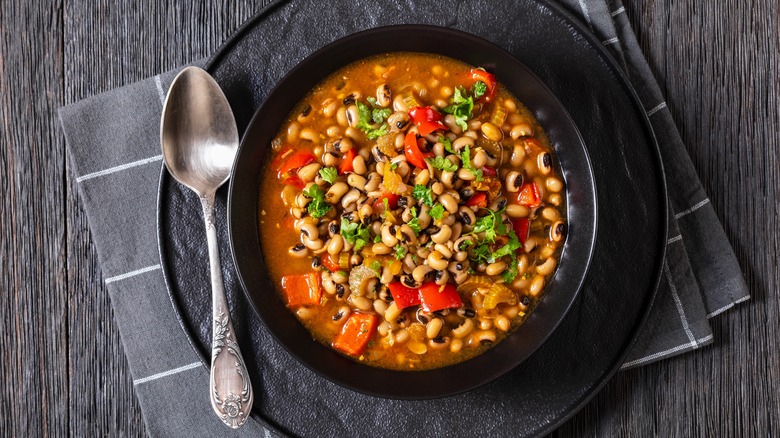Fresh Or Canned, Which Is Better For Collard Greens And Black Eyed Peas?
For many people, the holiday dinner table is not complete without tender collard greens and creamy black eyed peas. In addition to being Southern staples, these dishes are also two symbolic foods of Kwanzaa – and they can both take a bit of time and effort to make from scratch. You may be wondering if you really need to prep these veggies using all fresh ingredients, when perhaps canned is just as good.
Whether you cook your greens and beans separately or combine them into one delicious recipe, there are distinct advantages and disadvantages to fresh and canned versions. Fresh collard greens do require more preparation time, but their flavor is brighter, and you can ensure that they wind up neither soggy nor tough. Canned black eyed peas also save you hours of prep, but the trade-off is that you have less opportunities to infuse the legumes with flavor as they cook.
To balance ease and taste when cooking these vegetables, consider using fresh collard greens and canned black eyed peas. Boost the flavor of your collard greens by swapping the water for stock, and simmer them until tender. Then, add the canned black eyed peas in the last few minutes of cooking, so they do not fall apart. Even though the peas won't be quite as flavorful, you can still make a delicious dish by adding some heavy-hitting ingredients like smoked turkey wings, ham hocks, homemade vegetable broth, or even a couple of dried mushrooms for a meat-free savoriness.
Preparing holiday-ready fresh collard greens
While preparing fresh collard greens is a little bit time-consuming, it is not at all difficult. The benefit of serving a flavorful veggie that you can cook to your desired doneness outweighs the extra work. The fresh greens may come as a bunch of whole leaves, or already pre-washed, bagged, and chopped. While pricier than the whole leaves, pre-cut collards are a good compromise for cooks who are after a fresh taste, but still looking to save some time. Just avoid packages that have pieces of the tough stems mixed in, as you will have to tediously pick those out.
If you opt for a fresh head of collards, remove the stems in the same way that you would with kale. Hold the stem in one hand, and pinch the fingers of your other hand around the base of the leaf. Keep gripping the stem firmly, and pull upwards to strip the leafy part away. From there, you can tear the leaves into pieces or chop them up with a knife and get to cooking them with your favorite flavorings.
If fresh collards are simply not in the cards, there are also lots of ways to upgrade canned collard greens. If you're using tinned greens, it is a good idea to go for black eyed peas cooked from dried, so they have more texture. Otherwise, the mix of greens and peas may be a bit too mushy.
How to make black eyed peas in all their forms
Just like with other legumes, black eyed peas come out of the can pretty much ready to eat, which is a huge convenience for big holiday meals. All you need to do is drain and rinse them and the prep work is done. As long as you build a great flavor base using plenty of aromatics and a rich stock, it is okay that you are not making the beans from scratch — they will still be very tasty. Consider pairing them with lightly-sauteed bell peppers and onions, or some crispy bacon for a little crunch.
If you prefer to cook dried black eyed peas instead, they will take about an hour or so to simmer (and you need to soak them overnight first). You can also cook them for a few hours in the slow cooker to skip the soaking, or opt for a standard pressure cooker or Instant Pot, if you have one. Using one of these special gadgets, the peas will only take about half an hour to cook, but they still require the pre-work of sorting and washing.
There are also a couple more options besides canned or dried. For those who are able to shop at a well-stocked grocery store, you may be able to find fresh or frozen black eyed peas. These both cook up quite quickly and have a more vibrant taste than canned products, but they do not require nearly as much prep as dried beans.



